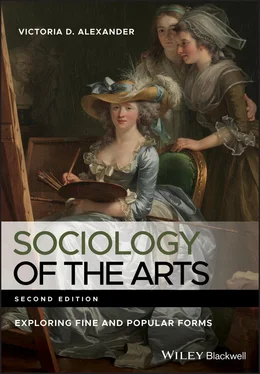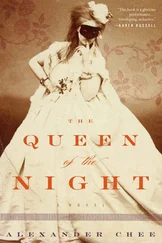Becker also suggests that we think of the definitional problems in relationship to art as an opportunity for research rather than as a problem: “Art worlds typically devote considerable attention to trying to decide what is and isn’t art…; by observing how an art world makes those distinctions rather than trying to make them ourselves we can understand much of what goes on in that world” (p. 36).
Becker’s comments are quite correct and we shall examine them in greater detail later. Assuming that we cannot define art formally and abstractly, there are, nevertheless, some elements that characterize most forms of art:
There is an artistic product. It may be tangible, visible, or audible. The product can be a physical object, like a book or record. Or it can be a performance, like a play or a concert.
It communicates publicly. To be art, the cultural product must not only exist, it must be seen, heard, touched, or experienced by an audience, either in public or private settings. All art is communication. Of course, not all communication is art.
It is experienced for enjoyment. “Enjoyment” can take many forms. Art might be consumed for aesthetic pleasure, for sociability and fun, for mental stimulation, or for escape. Sometimes, however, people are exposed to art because “it’s good for them,” as in a school trip to a museum.
Art is an expressive form. When art relates to real life, it presents a fiction or an interpretation. Sometimes art claims to tell the “truth,” but if it takes this idea too literally, it moves into the area of documentary, non‐fiction, or news.
Art is defined by its context, both physical and social. What is art in a museum or theater may be just odd objects or strange behavior in other settings. When different social groups view the same expressive product, they may disagree on whether or not it is art.
It is as important to understand what this book will not cover, as well as what it will cover. I exclude from analysis (1) popular culture in the broad sense, for instance, youth culture or commodity culture, and (2) the media in their informational, rather than entertaining, formats, for instance news, documentaries and the like, whether online or broadcast. Griswold (2013) distinguishes between implicit culture and explicit culture . Implicit culture is an abstract feature of social life: how we live and think. Explicit culture is a tangible construction, a performance or product that is produced—it is what I am calling “art.” The book analyses culture in the explicit sense, but does not attempt to address implicit culture systematically.
In place of a formal definition, a list of what is “art” and “not art” will help define the scope of the book (see Table 1.1). This book will cover: (1) The fine (or high) arts. For example: the visual arts (painting, sculpture, drawing, etching, and other works that you might find in an art museum), opera, live symphony and chamber music, recorded classical music, drama, theater, dance (ballet and modern), other performance art (experimental theater, happenings, etc.), literature and serious fiction, and digital art (art visible only in virtual environments), and art recently “promoted” to high art (e.g. jazz music, some cinema). (2) The popular (or low, or mass) arts. For instance: Hollywood movies, independent film (sometimes considered as fine art), television drama (series, serials, made‐for‐television movies), television sitcoms, best‐selling and pulp fiction, popular music (rock, pop, rap, etc.) including recorded music, rock concerts, and performances in pubs and clubs, and print, television, and online advertising. The fine and popular arts are the book’s main subjects, but we will also discuss (3) the folk arts, that is, artistic activities created in community settings. These include: some types of amateur music, garage rock music (e.g. as performed by teenagers), quilting (especially in quilt circles), and graffiti of the artistic (rather than the public toilet) kind, as well as a wide variety of DIY (do it yourself) creation distributed via the Internet, such as music or fanfiction. As mentioned, some types of art do not neatly fall into one of the categories, for instance, jazz can be either popular or high art, and, especially in its early forms, folk art (Lopes, 2002).
Table 1.1 What is Art? Manifestations of Culture Included and Excluded from Consideration in This Book
| Art (as defined in this book) |
Not Art (as defined in the book) |
 Fine art Opera Symphony Painting and sculpture Experimental performance art Dance – ballet, modern, etc. Literature Etc. Fine art Opera Symphony Painting and sculpture Experimental performance art Dance – ballet, modern, etc. Literature Etc.  Popular art Popular music (rock, pop, country, etc.) Popular fiction Movies & film (Hollywood, made‐for‐TV or Internet, and independent) Television drama (series, mini‐series) and sit‐coms (broadcast or for download) Advertising (print, television) Etc. Popular art Popular music (rock, pop, country, etc.) Popular fiction Movies & film (Hollywood, made‐for‐TV or Internet, and independent) Television drama (series, mini‐series) and sit‐coms (broadcast or for download) Advertising (print, television) Etc.  Folk art DIY art Amateur music Quilting Etc. Folk art DIY art Amateur music Quilting Etc.  The art of subcultures (but not how people in them live) The art of subcultures (but not how people in them live)  Art products on the Internet – digital art, virtual museums, (some) music, video, and images (when presented as fine, popular or DIY art), and the like. Art products on the Internet – digital art, virtual museums, (some) music, video, and images (when presented as fine, popular or DIY art), and the like. |
⊠ Popular culture (broadly stated) Fads and fashions Trends in clothing The meaning of blue jeans Attitudes towards hair coloring or body design (tattoos, piercing) Subcultures, as a way of life Youth cultures Consumerism Manufactured products that carry a cultural meaning (e.g. Levi’s, branded clothing, Coca‐Cola, mobile phones) Etc. ⊠ Sport ⊠ Media – in non‐fiction and news facets TV, print and Internet news Documentaries Current affairs True crime Science shows The Internet, in most of its aspects Etc. ⊠ Private expressive forms Personal sketches, watercolors, doodles Photos posted on Flickr/Instagram/Facebook, (most) videos on YouTube Art therapy Etc. ⊠ Lots and lots of other things |
| Gray Area(These fall outside the book’s definition, or at least its attention, but might have strong elements with respect to artness) |
| High fashionCooking, especially haute cuisine Demolition Derby, World Federation WrestlingComputer/digital games[etc.] |
This book will not cover: (1) Popular culture, in the broad sense. Many people use the term “popular culture” to mean what I refer to as the “popular arts.” Other people use it to mean something bigger. They mean “culture” as in Griswold’s implicit culture, an anthropological sense: “that complex whole of knowledge, habit and custom” (Tylor, 1924 [1871]: 1). It is this wider component of popular culture that I exclude. For instance, youth culture is excluded (but not the music that young people might enjoy—music is a popular art form); the lifestyles of subcultures are excluded (but not the art forms subcultures enjoy). I will not cover such topics as: trends in everyday clothing; the cultural meaning of blue jeans; attitudes towards hair coloring or body design (tattoos, piercing), consumer culture, and other customs and norms. (2) Sport is not art, and neither are (3) the non‐fiction and news facets of the media. Consequently, I will not consider sport or such media forms as television, print or Internet news, documentaries, current affairs shows, true crime, or science programs. The Internet has had an important impact on many forms of art, but it is a vehicle for art, like a museum, movie theater, or bookshop. I will not discuss the Internet as a media form in and of itself nor will I consider many of its key aspects such as email, information sites, blogs, chat rooms, or the like—though I will consider the Internet as an important site for the distribution and consumption of art.
Читать дальше

 Fine art Opera Symphony Painting and sculpture Experimental performance art Dance – ballet, modern, etc. Literature Etc.
Fine art Opera Symphony Painting and sculpture Experimental performance art Dance – ballet, modern, etc. Literature Etc. 










